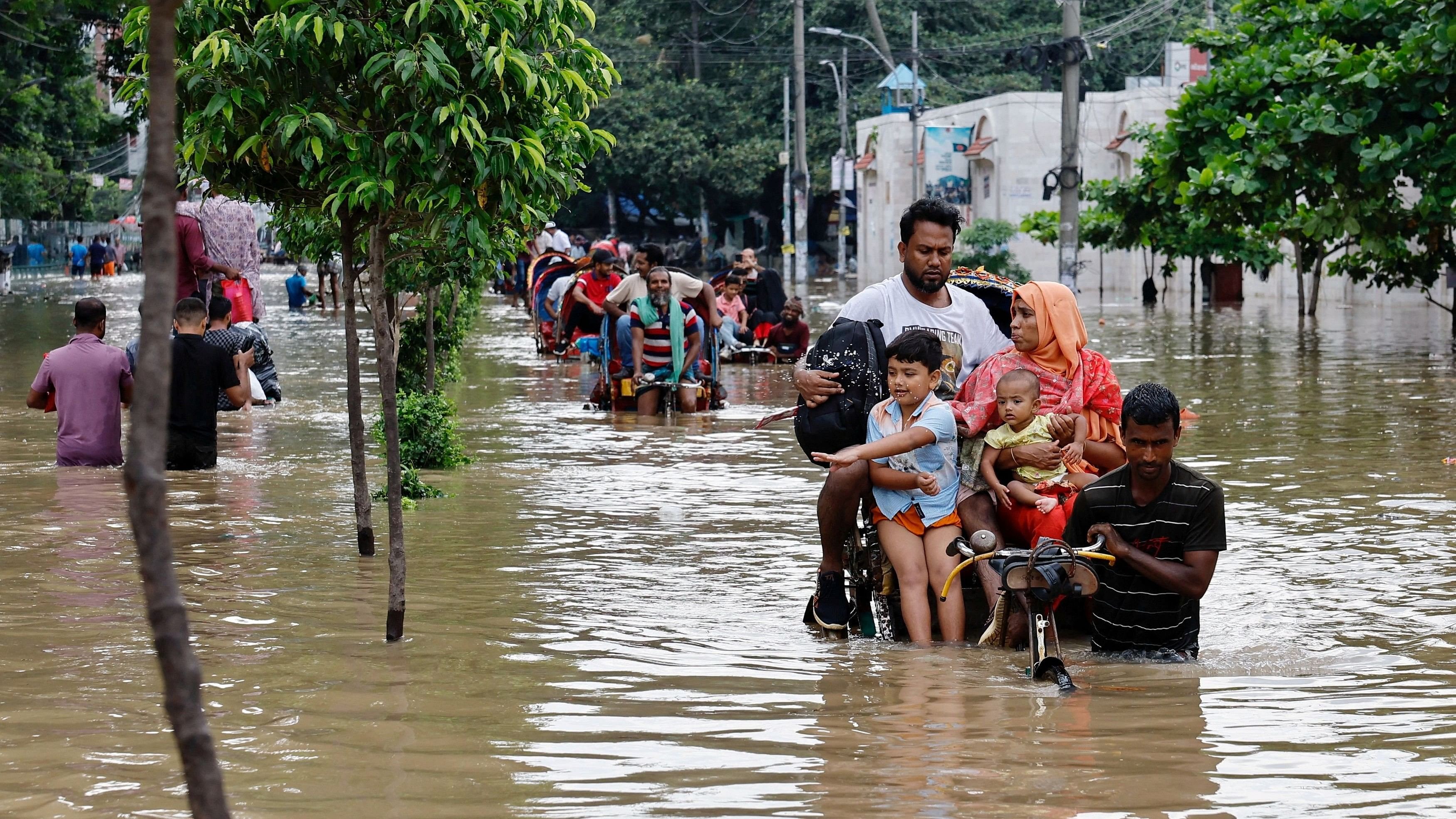
Hundreds of vehicles, including passenger bus services and lorries, plying from the Chattogram port city to Dhaka and elsewhere were stranded due to the sudden rush of water.
Credit: Reuters File Photo
Dhaka: Monsoon rainfall-triggered floods in deltaic Bangladesh and upstream Indian regions killed at least 13 people and marooned or affected nearly three million others in this country, posing a huge administrative challenge to the newly installed interim government amid a political transition.
Bangladesh is crisscrossed by more than 200 rivers, 54 of them being transboundary rivers with upper riparian India, in four major basins. A depression (a system that brings in copious rainfall) in the Bay of Bengal has led to the current deluge with rivers in two basins – the north-eastern Meghna Basin and south-western Chattrogram Hills Basin – flowing above the danger mark.
Apart from the torrential rains, the overflowing rivers, El Nino and climate change phenomenon were the factors responsible for widespread flooding in the country, weather experts said on Friday.
A Disaster Management Ministry spokesperson said: “We are monitoring the flood situation and relief activities from our control room in Dhaka.” Communications with the central Feni district, which is located almost midway between the capital Dhaka and the port city of Chattogram, was virtually cut off while flood waters largely submerged the district headquarters and the collapsed electricity supply system disrupted the telecommunication lines.
“The cross border Khowai in (northeastern) Habiganj now flows 199 centimetres or nearly 2 metres above the danger marks at places, the Gumti (in eastern Bangladesh) flow at 118 centimetres above danger mark and Halda in (southeastern) Chattagram 1 metre at places,” a spokesman of the Flood Warning and Forecasting Centre (FFWC) said about the situation on Friday afternoon.
The FFWC, however, said heavy downpour was not observed in the past 24 hours and they are expecting the water level to recede gradually.
The FFWC office came under criticism for failure to predict the situation even as the officials attributed the situation to a lack of information from counterparts in the upstream Indian region.
According to local media reports, the situation became bizarre as local government representatives were unavailable or on the run because of their political affiliation after the ouster of former prime minister Sheikh Hasina’s Awami League regime in a student-people upsurge earlier in the month. That made it difficult for relief coordination, the media reports said.
The floods have hit the country as interim leader Muhammad Yunus is overhauling the bureaucracy by changing their heads.
The new government has also sacked more than 1,800 elected local government representatives across the country since Yunus assumed charge on August 8. Hasina, 76, stepped down on August 5 and fled to India amidst a mass uprising that followed attacks, vandalism and killings of many people loyal to her.
Hundreds of vehicles, including passenger bus services and lorries, plying from the Chattogram port city to Dhaka and elsewhere were stranded due to the sudden rush of water blocking the two major highways, which in turn not just isolated people but hampered the rescue efforts.
Several rivers surpassed their bank lines, particularly in north-eastern eastern and south-eastern Bangladesh inundating many cities and towns alongside several hundred villages killing the people, damaging the infrastructures and disrupting communication lines.
“I have never seen or heard of any such flood in (central) Feni district in my life,” 93-year-old income tax lawyer Kazi Golam Manuddin told PTI from Feni – about 130 km southeast of Dhaka, near Bangladesh-India border with Tripura on the other side - on phone as he was forced to move out of his home to take refuge in a relatively dry area.
Disaster management officials said most of the deaths were caused by drowning while electrocution and felling of trees were other reasons for the casualties but the sudden deluge caused by gushing waters split many families while many people were forced to take refuge on highways or rooftops.
Firefighters with the help of local residents, Red Crescent volunteers, police and army troops rescued many stranded people in their rubber crafts. At one place a minor child was seen standing in chest-deep water and at another spot a young mother was seen sitting on a pile of bricks with her infant child on her lap being isolated from the rest of their families before being rescued.
Even when several experts attributed the sudden flooding to climate change, a 2015 World Bank study estimated that 3.5 million people in tropical Bangladesh are vulnerable (to floods) because of its geophysical topography.
According to FFWC, the most affected districts in Bangladesh included eastern or centre-east Cumilla, Feni, north-eastern Moulvibazar, Habiganj and south-eastern Chattrogram, where five major rivers were flowing above danger levels.